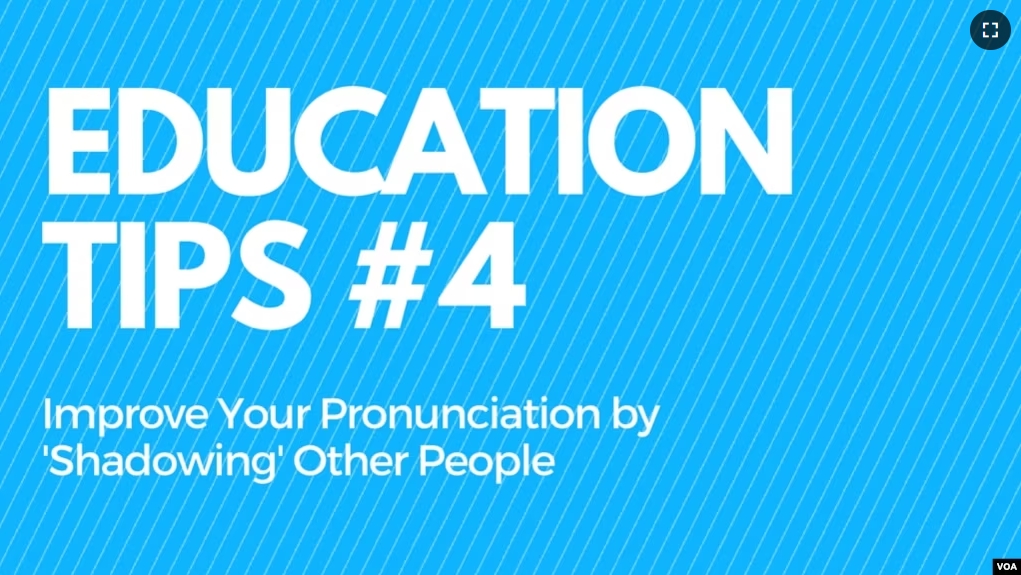Many English learners can improve their pronunciation by listening carefully to native English speakers and trying to match the up-and-down movement of their sentences.
That is the opinion of Marla Yoshida, an English as a Foreign Language teacher at the University of California, Irvine.
Yoshida wants English learners to look for details that are important to native speakers. These details are not only sounds, she notes. Native speakers also communicate by using pauses, and by saying some words more forcefully than others.
As a result, native speakers might not understand an English learner even if the learner pronounces sounds correctly.
The problem with ‘listening and repeating’
Yoshida says that English learners often study pronunciation by listening and repeating something from a recording.
Yoshida says that English learners need to do more than listen and repeat in order to improve their pronunciation:
“I’ve gradually gotten really interested in pronunciation because it’s something that students have trouble with, but they don’t always get a lot of really good instruction in it. They just have someone say ‘Listen to this recording and repeat … and now, aren’t you better?’ No! You’re not necessarily better. It takes more than that.”
The problem with listen and repeat, says Yoshida, is that when people repeat, they are often not trying to sound like the other person.
“You think that when students are repeating after the teacher, or whatever, they’re trying to sound exactly like that person, but they’re not.
The sounds that you hear go into your brain … and your brain interprets them or filters them through the sound system of your own language, and what your brain ends up understanding is not everything – it’s not what the speaker intended…
You have to try to get past that filter and hear all of the details that are important to someone else.
So you have to try to duplicate what the person is saying.”
What details should you try to copy when you listen to an English speaker? Among others, the important details include pauses or breaths, which words to emphasize — or give special attention to, and intonation – the up and down movement of your voice as you speak.
English speakers, in particular, use a broad range of up and down movements in their voices. These movements can be difficult for English learners to recognize and understand.
Native English speakers might have difficulty understanding English learners when learners use a narrow range of their voice. In other words, native speakers have fewer vocal restrictions when they are speaking. English learners also may use intonation patterns that are different from those in Standard English.
Studying how native speakers use intonation will help English learners better understand what native speakers do with their voices.
Practical tips:
If English learners want to start improving their pronunciation, Yoshida suggests that they do an activity called shadowing.
“Shadowing means finding a short audio or video clip that you like… that’s maybe 30 seconds long, one minute long, at most two minutes long, and listen to it. Listen to it a couple of times to get the meaning, and to hear where the speaker pauses, and what they emphasize … and what the intonation sounds like – because those are really important things too – not just the sounds. Pronunciation is much more than saying each sound correctly because you can say each sound correctly and still sound really hard to understand…
So, find a short clip, listen to it, mark things that you notice, then listen a few more times just to sort of let those sounds become a part of your brain, and then start imitating. And imitate trying to sound exactly like that person.”
What does shadowing look like?
Here is a short example of what a shadowing activity could look like.
The example comes from Martha Kolln’s book Rhetorical Grammar*:
“One of the most important aspects of your expertise with sentences is your sense of rhythm.”
Listen to the sentence several times.
Then try to mark the intonation of the voice. Listen for emphasized words.

In the sentence, you can hear that some syllables are emphasized, while others are not. Overall, the voice falls after important syllables, notably at the end of the sentence.
English sentences often emphasize words at the end of a sentence – the place where you usually find new information. The next time you are reading and listening to a story, try to mark the patterns of intonation that you hear.
Remember, all our stories have audio, so you can print the story and do a shadowing exercise while listening to the story. Give shadowing a try, and let us know how it works for you!
I’m John Russell.
John Russell wrote this lesson for VOA Learning English. George Grow and Kelly Jean Kelly were the editors.
Tim Murphey, a teacher in Japan, has a video of students doing shadowing and summarizing. You can watch it on YouTube here:
*Kolln, Martha. Rhetorical Grammar, 3rd Edition. Allyn and Bacon,1999. pg. 24
We want to hear from you. Write to us in the Comments section.
__________________________________________
Words in This Story
pronunciation – n. the way in which a word or name is pronounced
pronounce – v. to make the sound of a word or letter with your voice
interprets – v. explains the meaning of something
filters – v. passes something through a filter to remove something unwanted
duplicate – v. to make an exact copy of something
emphasize – v. to give special attention to something : to place emphasis on something
intonation – n. the rise and fall in the sound of your voice when you speak
range – n. all the notes that a particular person can sing or that a particular musical instrument can make
syllable – n. any one of the parts into which a word is naturally divided when it is pronounced
